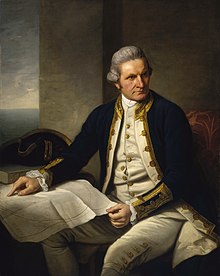
Back James Cook Afrikaans James Cook ALS ጄምስ ኩክ Amharic James Cook AN Iacobus Cōc ANG جيمس كوك Arabic دجيمس كوك ARY جيمس كوك ARZ জেমছ কুক Assamese James Cook AST
James Cook | |
|---|---|
 Portrait by Nathaniel Dance-Holland, c. 1775 | |
| Born | 7 November 1728 |
| Died | 14 February 1779 (aged 50) Kealakekua Bay, Hawaii |
| Education | Postgate School, Great Ayton |
| Occupation(s) | Explorer, cartographer and naval officer |
| Spouse | |
| Children | 6 |
| Military career | |
| Branch | Royal Navy |
| Service years | 1755–1779 |
| Rank | Captain (Post-captain) |
| Battles / wars | |
| Signature | |
 | |
Captain James Cook FRS (7 November [O.S. 27 October] 1728 – 14 February 1779) was a British explorer, cartographer, and naval officer famous for his three voyages between 1768 and 1779 in the Pacific Ocean and to New Zealand and Australia in particular. He made detailed maps of Newfoundland prior to making three voyages to the Pacific, during which he achieved the first recorded European contact with the eastern coastline of Australia and the Hawaiian Islands and the first recorded circumnavigation of New Zealand.
Cook joined the British merchant navy as a teenager and joined the Royal Navy in 1755. He served during the Seven Years' War and subsequently surveyed and mapped much of the entrance to the St. Lawrence River during the siege of Quebec, which brought him to the attention of the Admiralty and the Royal Society. This acclaim came at a crucial moment for the direction of British overseas exploration, and it led to his commission in 1768 as commander of HMS Endeavour for the first of three Pacific voyages.
In these voyages, Cook sailed thousands of miles across largely uncharted areas of the globe. He mapped lands from New Zealand to Hawaii in the Pacific Ocean in greater detail and on a scale not previously charted by Western explorers. He surveyed and named features, and recorded islands and coastlines on European maps for the first time. He displayed a combination of seamanship, superior surveying and cartographic skills, physical courage, and an ability to lead men in adverse conditions.
During his third voyage in the Pacific, Cook encountered the Hawaiian islands in 1779. He was killed while attempting to take hostage Kalaniʻōpuʻu, chief of the island of Hawaii, during a dispute. He left a legacy of scientific and geographical knowledge that influenced his successors well into the 20th century, and numerous memorials worldwide have been dedicated to him. He remains controversial for his occasionally violent encounters with indigenous peoples and there is debate on whether he can be held responsible for paving the way for British imperialism and colonialism.